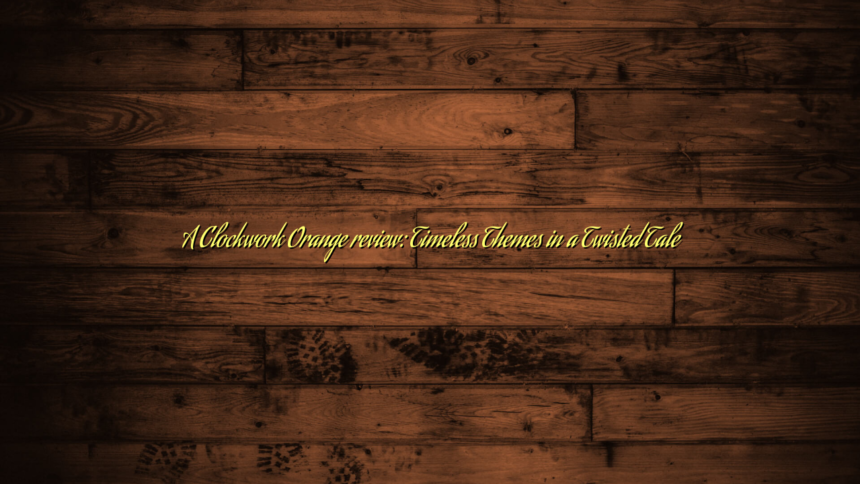A Clockwork Orange review
“A Clockwork Orange,” directed by Stanley Kubrick and primarily based on the novel by Anthony Burgess, has etched its identify into the annals of cinematic historical past. Since its launch in 1971, this controversial movie has sparked conversations about morality, free will, and societal management. As you dive deeper into this A Clockwork Orange evaluate, you’ll uncover how its timeless themes resonate even right this moment, making it a must-watch for movie fans and newcomers alike.
On this article, we’ll discover the multifaceted elements of A Clockwork Orange, from its daring narrative fashion to the psychological undertones that proceed to impress thought. We’ll dissect the principle themes and motifs, analyze the characters, focus on its visible aesthetics, and study its lasting impression on widespread tradition. Be part of us as we peel again the layers of one in all cinema’s most provocative works.
The Plot Synopsis: A Journey By way of Dystopia
At its core, A Clockwork Orange follows the story of Alex DeLarge, a younger delinquent who delights in “ultraviolence.” Set in a dystopian future, the movie paints a grim portrait of a society suffering from crime and ethical decay. After being captured for homicide, Alex turns into a topic of a controversial rehabilitation experiment referred to as the Ludovico Approach. This aversion remedy goals to situation him towards violence, successfully stripping away his free will.
The movie’s narrative construction operates on a non-linear path, mixing surrealism with stark actuality. With its unsettling imagery and distinctive storytelling, viewers expertise the brutal world via Alex’s eyes, complicating our notion of villainy and victimhood.
Timeless Themes Explored in A Clockwork Orange
Free Will and Alternative
One of the crucial profound themes of A Clockwork Orange is the idea of free will. As Alex undergoes behavioral conditioning, the query arises: Is it higher to decide on to be dangerous than to be pressured to be good? Kubrick’s adaptation forces viewers to confront the essence of human nature and the ethical implications of company. The transformation of Alex from a violent predator to a docile citizen raises questions on manipulation, morality, and private accountability.
The Risks of State Management
On this A Clockwork Orange evaluate, one other essential side is the critique of governmental energy. The movie underscores the hazards of a state that prioritizes conformity over particular person freedom. The usage of violent means by authorities to impose order displays a totalitarian strategy, prompting viewers to query the ethics of societal management. This theme resonates in modern discussions about surveillance and private liberties, showcasing the movie’s relevancy throughout generations.
The Nature of Violence
A Clockwork Orange presents violence not simply as a software however as a type of self-expression. By way of Alex and his “droogs,” Kubrick examines the attract of violence and its aesthetic potential. The stylized depictions present a paradoxical magnificence to brutality, compelling the viewers to grapple with their perceptions of violence in society. This theme is especially pertinent in right this moment’s media panorama, the place violence is usually sensationalized.
The Characters: A Examine in Ethical Ambiguity
Alex DeLarge: The Antihero
Alex is the quintessential antihero, capturing the viewers’s fascination and repulsion concurrently. His charisma attracts viewers into his morally ambiguous world, but his actions provoke widespread horror. By way of Alex, Kubrick explores the complexity of human need and brutality, leaving audiences to replicate on their interpretations of fine and evil.
The Droogs: Loyalty and Betrayal
Alex’s companions, referred to as the “droogs,” every embody varied sides of loyalty and betrayal. Their interactions reveal the dynamics of friendship within the context of violence. The superficial camaraderie provides strategy to treachery, illustrating the fragility of relationships amid chaos. This evaluation of friendship provides one other layer of depth to the A Clockwork Orange evaluate.
The Authority Figures: The Flawed Techniques
Figures just like the jail chaplain and the federal government officers replicate the flawed techniques of management and rehabilitation. Every character represents completely different elements of societal roles and failures, additional accentuating Kubrick’s criticism of institutional energy. Their ineffectiveness highlights the hazards of reliance on authority quite than particular person ethical judgment.
Visible Aesthetics: A Feast for the Eyes
An indicator of A Clockwork Orange is Kubrick’s outstanding visible fashion, which blends vivid imagery with unsettling symbols. The usage of contrasting colours, avant-garde costumes, and meticulous set designs contributes to the movie’s dreamlike high quality. The notorious “Singin’ within the Rain” sequence is a standout second that juxtaposes cheerfulness with horrific violence, encapsulating the movie’s thematic dichotomy.
Music and Sound Design
The rating, composed by Wendy Carlos and Rachel Elkind, enhances the environment, mixing classical music with digital components. The progressive use of sound elevates the emotional impression of key scenes, guiding viewers’ reactions and reinforcing the movie’s themes. The soundtrack’s juxtaposition with the visuals stimulates a deeper reflection on the narrative.
Cultural Influence: A Lasting Legacy
Since its launch, A Clockwork Orange has change into a touchstone in widespread tradition, inspiring filmmakers, writers, and artists worldwide. Its daring exploration of complicated themes has influenced numerous works within the realms of literature and cinema. The movie stays a degree of reference in discussions concerning the nature of evil and societal buildings, highlighting its enduring relevance.
Controversy and Censorship
The movie’s express content material has triggered important controversy, resulting in censorship in varied international locations. This backlash, whereas detrimental to some, inadvertently fueled its cult standing. The extreme debates surrounding its morality immediate reflections on censorship and creative freedom, making it a pertinent instance in right this moment’s cultural conversations.
Conclusion: Revisiting A Clockwork Orange
In conclusion, this A Clockwork Orange evaluate underscores the movie’s multifaceted exploration of timeless themes equivalent to free will, state management, and the character of violence. Stanley Kubrick’s audacious route and Anthony Burgess’s thought-provoking narrative provoke deeper inquiries into human nature and the moral implications of societal buildings.
Actionable Insights
- Watch with Intention: Method the movie with an analytical mindset. Take into account the philosophical questions it raises about morality and free will as you watch.
- Replicate on Trendy Relevance: Take into consideration how the themes mentioned relate to present societal points, equivalent to state management and media portrayals of violence.
- Interact with Communities: Be part of boards or discussions to share insights and interpretations with others who’ve encountered the movie’s complicated narrative.
- Discover Associated Media: delve into associated literature or movies that discover comparable themes to broaden your understanding of the subject.
By revisiting A Clockwork Orange, audiences can interact with the complicated ethical dialogues it presents and reaffirm its standing as a cornerstone of cinematic discourse. This movie isn’t just a viewing expertise; it’s a catalyst for thought, guaranteeing its place within the dialogue of artwork and morality for generations to come back.




